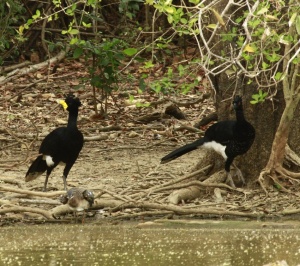- Crax daubentoni
Identification
84–92·5 cm (33-36½)
- Black overall plumage with a blue gloss
- White lower abdomen and under-tail coverts
- White-tipped tail feathers
- Black central pair
- Curly crest
- Yellow fleshy knob and wattles at bill base
Sexes similar
Male: yellow cere
Female: white markings on crest and bars on breast and upper belly
Similar Species
Great Curassow which also has a fleshy yellow knob at base of bill; it is also black, but has a green gloss. Can be separated by range, as Great Curassow only occurs in extreme western Colombia, Panama and Ecuador (where it is very rare).

Distribution
South America: North Venezuela (north of the Orinoco River) and a few scattered areas in north-eastern Colombia.
Taxonomy
This is a monotypic species[1].
Habitat
Gallery forests and tall scrub.
Status
Numbers are declining due to habitat loss and hunting, giving a BirdLife status of Near Threatened.
Behaviour
Breeding
Both adults build the nest, which is raised above the ground. The clutch consists of 2 eggs.
Diet
Almost half their diet consists of fruit and seeds. They also eat insects, leaves, flowers, roots, fungi, earth and gravel.
Vocalisation
Call: a long, clear whistle, rising and falling until it fades away.
References
- Clements, J. F., T. S. Schulenberg, M. J. Iliff, D. Roberson, T. A. Fredericks, B. L. Sullivan, and C. L. Wood. 2015. The eBird/Clements checklist of birds of the world: v2015, with updates to August 2015. Downloaded from http://www.birds.cornell.edu/clementschecklist/download/
- Handbook of the Birds of the World Alive (retrieved November 2015)
- ArKive
- BirdLife International
Recommended Citation
- BirdForum Opus contributors. (2025) Yellow-knobbed Curassow. In: BirdForum, the forum for wild birds and birding. Retrieved 10 May 2025 from https://www.birdforum.net/opus/Yellow-knobbed_Curassow





